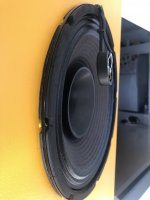im using a series capacitor as hi pass filter for the AMT tweeter. what does the buildup means? how can i improve it?
the measurement is taken from my listening position. no acoustic treatment, open baffle full range speakers.
thanks

the measurement is taken from my listening position. no acoustic treatment, open baffle full range speakers.
thanks
Last edited:
It means something rings. First i suggest that you make sure it really is a tweeter and not mid.
Measure each driver separately please.
It could be mid breakups ringing. Or tweeter crossed too low, and needs higher fr crossover, or just steeper slope. One cap in series plus inductor parallel in tweeter. I bet you get incressed distortion in that spot too.
Measure each driver separately please.
It could be mid breakups ringing. Or tweeter crossed too low, and needs higher fr crossover, or just steeper slope. One cap in series plus inductor parallel in tweeter. I bet you get incressed distortion in that spot too.
thank you, i will separate the speaker and tweeter response and check where the ringing is and aluminate it.It means something rings. First i suggest that you make sure it really is a tweeter and not mid.
Measure each driver separately please.
It could be mid breakups ringing. Or tweeter crossed too low, and needs higher fr crossover, or just steeper slope. One cap in series plus inductor parallel in tweeter. I bet you get incressed distortion in that spot too.
It looks like a measurement error to me or the software cannot interpret what happens. I cannot think of anything physical with non-decaying sustain, followed by a sudden drop-off, which only happens at high frequencies.
Thinking out loud:
I think that the software that generates the waterfall plot can only handle decaying sound. If you measure at the listening position, this is not necessarily what happens. It appears that the direct sound hits the microphone [time 0], decays, after which reflected sound hits the microphone [time 160]. The software registers that the level has increased and assumes something went wrong, so all earlier data in the plot [before time 160] is lifted to the same magnitude.
Thinking out loud:
I think that the software that generates the waterfall plot can only handle decaying sound. If you measure at the listening position, this is not necessarily what happens. It appears that the direct sound hits the microphone [time 0], decays, after which reflected sound hits the microphone [time 160]. The software registers that the level has increased and assumes something went wrong, so all earlier data in the plot [before time 160] is lifted to the same magnitude.
Last edited:
hi @dudwity,
with your settings i think you are measuring mainly your room instead of the speaker.
have a look here: https://www.audiosciencereview.com/...aker-measurement-waterfall.21753/#post-722739
have a look what your waterfall plots look like if you use these settings:
window: 6,5 ms
time range: 4 ms
rise time: 0,2 ms
with your settings i think you are measuring mainly your room instead of the speaker.
have a look here: https://www.audiosciencereview.com/...aker-measurement-waterfall.21753/#post-722739
have a look what your waterfall plots look like if you use these settings:
window: 6,5 ms
time range: 4 ms
rise time: 0,2 ms
Hi thanks. I need to connect the setup again. But yes its from the listening position so the room is a factor. Im happy with the sound and i dont think its an issue.Looks like dudwity has left the building.
which tweet and what value cap ?
seeing how the signal is dropping then straight out, I suspect measuring.
but, I have no idea.....................
seeing how the signal is dropping then straight out, I suspect measuring.
but, I have no idea.....................
The tweeter amt called mini 8 and is pointed toward the woofer ilike it more like that. The cap is foil 5.6uf.which tweet and what value cap ?
seeing how the signal is dropping then straight out, I suspect measuring.
but, I have no idea.....................
Attachments
- Home
- Loudspeakers
- Multi-Way
- waterfall of full range and AMT tweeter, what does the "build up" in the hi frq mean?
